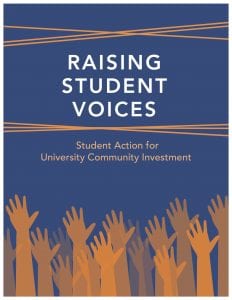
Certainly, intermediaries have an important role to play. In Cleveland, for example, the Cleveland Foundation acted as an intermediary when it brought University Hospitals, Cleveland Clinic, Case Western Reserve University, and other area anchor institutions together to engage in community wealth building through its Greater University Circle strategy. In Baltimore, the Central Baltimore Partnership, led by Joe McNeely, is acting as an intermediary between Johns Hopkins University and the surrounding communities in a 10-neighborhood effort known as the Homewood Community Partners Initiative.
A missing element, however, is the student voice. One group trying to change this is the Responsible Endowments Coalition (REC). Founded in 2004 by students on five campuses, REC now works with more than 100 campuses nationwide. A central premise: “Colleges and universities, controlling over $400 billion dollars, have a responsibility to make a more sustainable and socially just endowment a reality.”
Recently, The Democracy Collaborative partnered with REC to examine the potential to take student-university-community-intermediary collaboration to scale. Titled Raising Student Voices: Student Action for University Community Investment, the report profiles administration-led efforts at Duke, University of Pennsylvania, and Case Western, and student-led initiatives at the University of Chicago, Wesleyan, and Fordham.
At Chicago, Wesleyan, and Fordham, students succeeded in persuading university officials to deposit funds at local community financial development institutions (CDFIs), thereby increasing, albeit modestly ($500,000 to $1 million), locally available capital for community lending. In some cases, students, once organized, found they were pushing at an open door. Fordham, a Jesuit institution with a social mission, deposited funds in 2011 in two local community development banks. At Wesleyan, administrators accepted a similar recommendation of a university committee consisting of five students, two faculty members, two staff members, and two alumni. At Chicago, officials agreed to deposit a total of $1 million in four community development financial institutions, in part because it was seen as consistent with the institution’s community engagement strategy.
Importantly, the report also examines the broader potential for students, in partnership with intermediaries, to lend a helping hand in encouraging universities to adopt effective strategies that leverage investment, hiring, and purchasing to empower low-income residents, support local business, and generate sustainable economic development.
In recent years, just as more schools, such as Syracuse, have directly taken on the mantle of being community-minded anchor institutions, student involvement in communities has also increased dramatically. According to Campus Compact, between 2008 and 2012, the percentage of students from its nearly 1,200 member campuses (about 6 million students) participating in community work jumped from 30 percent to 44 percent, while the value of that labor power increased from $5.7 billion to $9.7 billion.
To date, few students have moved beyond small group or class projects to encouraging their universities as institutions to support community building. Yet that may be changing. The idea of students pushing universities to change policy is not new. Between 1985 and 1988, for example, student campaigns led more than 100 schools nationwide to divest from companies that had invested in apartheid South Africa. Today, a new divestment movement seeks divestment from fossil fuel companies. Already, six university boards of trustees have voted to divest. Implicitly, this opens a window for efforts to support reinvestment of the divested funds into local communities.
Of course, this will not happen by itself. The challenge of student turnover, for example, must be addressed. Intermediaries might help students develop stronger ties with community groups and vice versa. Not only would this help with campaign continuity, but it would also give community groups another “in” to the university while increasing their ability to shape more lasting and effective projects.






Comments